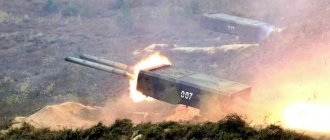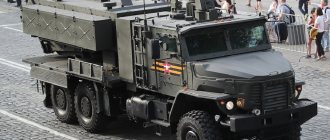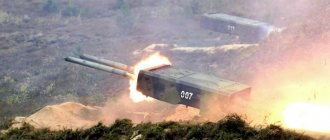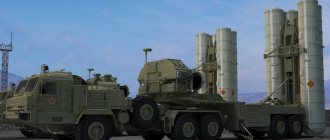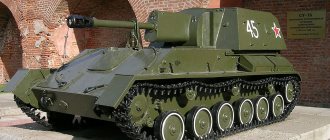At the end of the 70s. The development of a heavy flamethrower multiple launch rocket system began. The system was a installation with unguided rocket projectiles. TOS-1 "Buratino" was created on the basis of the T-72 tank. During development, the system was designated “Object 634”. TOS-1 was first used during the Afghan war. The goals of creating a heavy flamethrower installation required it to be installed on a chassis with significant carrying capacity. The designers also had to take into account the relatively low firing range and install a certain level of protection on the combat vehicle. All this significantly made the multiple launch rocket system heavier.
Photos
Epilogue
The system, despite the armor from the T-72, is vulnerable due to its lightly armored ammunition and short firing range. Damage to the launcher by small-caliber weapons can lead to spontaneous detonation or the launch of unguided missiles, which can cause great damage to friendly troops.
There are MLRS Uragan or Grad, which fire at a distance many times further, but in modern wars small mobile groups rapidly moving across the terrain are increasingly used. Firing at them from a distance of tens of kilometers is almost pointless.
Pinocchio acts much faster, and the result of its use is noticeable immediately. In 90 seconds the system is completely ready to fire, firing the entire ammunition load in 6 seconds if necessary.
History of creation
The development was carried out in 1971-1979 in Omsk, at the Transport Engineering Design Bureau. Prototypes based on the T-72 chassis were produced there in 1978-1979. The complex included a transport-loading system based on the KrAZ-255B chassis and a combat vehicle - a launcher with a package of thirty guides on the T-72 chassis. During testing and development, the vehicle was designated "Object 634". In 1980, it passed state tests, then it was put into service. Debut participation in combat conditions took place in Afghanistan in the late 80s.
The functionality is to eliminate manpower located, in particular, in fortifications with the help of a shock wave or fragments created on the territory of the target during the massive use of unguided rockets in smoke-incendiary and thermobaric equipment, destruction and arson of buildings and structures, incapacitation automobile and light armored vehicles.
Demonstrated to the general public in Omsk in 1999.
TOS-1A. The ruthless “Sunshine”, which has no analogues in the world (video)
The modernization of this mobile tracked flamethrower was carried out by specialists from the Omsk Transport Engineering Plant (part of the UVZ group). As the press service of the enterprise reported, changes in the Solntsepek affected both the appearance and internal equipment of the machine.
In particular, the TOS-1A is equipped with a modern power plant and an updated dynamic protection complex, the flamethrower also received a new launcher, and the transport-loading vehicle of the complex received a crane-manipulator of a modern design. TOS-1A is the most mobile, protected and most powerful flamethrower system in the world. The basis for it was the chassis of the T-72 tank. The multi-barrel flamethrower is capable of hitting lightly armored targets, vehicles, and destroying buildings.
The system is effective both in open areas and when destroying the enemy hiding in fortifications. "Solntsepek" is used in combat formations of supported troops, and is used with open police forces. At the same time, modern sighting equipment allows it to be used just as successfully at a distance from the line of contact with the enemy. In terms of the implemented technical solutions, the range of tasks solved and combat effectiveness, this weapon has no analogues in the world and is a unique development of Russian gunsmiths.
In terms of functionality, the TOS-1A is a multiple launch rocket system. The complex includes a BM-1 combat vehicle and two TZM-T transport-loading vehicles, also built on a tank chassis. A full salvo of “Solntsepek”, the duration of which does not exceed six seconds, from all 24 guides, is capable of covering an area of up to 70 square kilometers. It is worth saying that the basis for the creation of TOS-1A was the mobile flamethrower of the previous design TOS-1 “Buratino”. As the press service of Omstransmash said, the current version of the flamethrower system is equipped with an improved launcher and an automated guidance system, and more powerful 220-mm caliber rockets are now used as ammunition. The Solntsepek fire can be fired in pairs and single shots, hitting enemy targets at ranges from 4 to 6 kilometers.
Last year, Omsktransmash carried out the first experimental overhaul of the transport-loading vehicle of the TOS-1A system and, based on the results of the work performed, received permission from the Russian Ministry of Defense to update such vehicles, now on a planned basis. In October of this year, a month before the end of the contract, the plant shipped to the customer a transport-charging machine with improved characteristics that meet modern requirements. “During this time, the company’s specialists have fully mastered all the necessary operations, honing their skills from machine to machine,” notes plant general director Igor Lobov. “We are the only company capable of carrying out such work quickly and efficiently.”
It's impossible to survive
The capabilities of “Buratino”, developed in our country back in the 1970s, were once closely “acquainted” with the Afghan Mujahideen during an operation against them in the Charikar Valley and South Salang. The effect of thermobaric ammunition (the basis of TOS combat equipment) had a much greater effect in the mountains due to the mutual superposition of air shock waves and their multiple reflections from the surrounding rocks. When the ammunition explodes, it creates a cloud of mixture and then ignites it, causing oxygen to react. The pressure rises sharply and then drops below atmospheric pressure: thus, even if the enemy managed to survive the explosion, hiding from the shock wave and high-temperature pulse, the pressure drop leads to his death.
The use of TOS also turned out to be extremely successful during the second Chechen campaign - in particular, in the battles for the village of Komsomolskoye. It is known that after just a few volleys of the Buratino launcher, the resistance of the militants settled in the area was broken. There is information that TOS, which are in service with Syria and Iraq, are also used during the current operation against ISIS militants (an organization banned in Russia), where they also show their best fighting qualities.
What makes these flamethrower systems effective is not only the monstrous “destructive power” of the ammunition, but also the high accuracy of fire, even when carried out in salvos. In this case, the launcher is guided in an automated mode, and the fire control system takes over measuring the range, calculating elevation angles, and takes into account air temperature, atmospheric pressure, wind speed and direction. Fire from the Solntsepek can be fired without leaving the vehicle: in battle, this circumstance can save the life of the crew, especially considering that the vehicle is adapted to work on the front line, because the minimum firing range of the TOS-1A is only 400 meters. The idea to place the firing installation and support systems on tank platforms - on a tracked chassis - also turned out to be successful. Thanks to this, the complex is not only protected by reliable armor, but can also make marches at speeds of up to 60 kilometers per hour, overcome fords more than 1.2 meters deep, dig in on its own and set up smoke screens.
Best among the best
According to experts, the design features of the Solntsepek make this vehicle unsurpassed in the class of infantry fire weapons. With approximately comparable firepower, other rocket systems - the same MLRS Grad, Uragan, Smerch, American MLRS, German LAPS and French RAFAL - are not capable of firing at targets located at a distance of less than half a kilometer. For the listed MLRS, the effective range of use is several thousand meters, and in a direct combat clash these systems are useless.
According to Andrei Frolov, editor-in-chief of the Arms Export magazine, the TOS-1A Solntsepek has no analogues in the world.
Tags: latest weapons Russian weapons Russian production made in Russia
Performance characteristics
4.1 Dimensions
- Length in stowed position, cm: 686
- Width in stowed position, cm: 346
- Height in stowed position, cm: 260 (estimate)
- Ground clearance, cm: 47
4.2 Armament
- Caliber, mm: 220
- Barrel length, mm: 5000 (estimate)
- Number of guides: 24 (30)
- Firing range min., m: 400
- Firing range max., m: 3600 (with new missiles - up to 6000)
- Damage area, m²: up to 40,000
4.3 Mobility
- Engine type: diesel V-12
- Maximum speed on the highway, km/h: 65
- Cruising range on the highway, km: 550
- Wheel formula: tracked chassis
4.4 Other parameters
- Weight in firing position, t: 46
- Crew, people: 3
Epilogue
The system, despite the armor from the T-72, is vulnerable due to its lightly armored ammunition and short firing range. Damage to the launcher by small-caliber weapons can lead to spontaneous detonation or the launch of unguided missiles, which can cause great damage to friendly troops.
There are MLRS Uragan or Grad, which fire at a distance many times further, but in modern wars small mobile groups rapidly moving across the terrain are increasingly used. Firing at them from a distance of tens of kilometers is almost pointless.
Pinocchio acts much faster, and the result of its use is noticeable immediately. In 90 seconds the system is completely ready to fire, firing the entire ammunition load in 6 seconds if necessary.
Why "Pinocchio"
Why does the heavy flamethrower system have such an unusual name? Typically, weapons are named after natural phenomena (most often destructive), various animals, or historical types of weapons. Some types of Soviet and Russian weapons have very poetic names (“Carnation”, “Acacia”, “Bassoon”). But why was the installation, which is designed to incinerate enemies in the literal sense of the word, named after the main character of a good children's fairy tale?
The reason for this was the shape of the missiles used by this system. Each of them has a thin detonator fairing in the nose. In shape, it is very similar to the long nose, which was the main distinguishing feature of Pinocchio.
This fairing is necessary to create a volumetric explosion. Thanks to this design feature, the ammunition does not explode immediately after hitting the surface, but first spreads a cloud of flammable mixture around itself and only then sets it on fire. The detonation of the flammable mixture in Buratino TOS missiles occurs at a lower speed, but it is extended over time and can “flow” into shelters or around obstacles.
The main type of ammunition used by the Buratino and Solntsepek installations are thermobaric rockets. The main damaging factors of their action are high temperature and strong pressure drop.
After the ammunition is detonated, a mixture of air and explosive is formed in the air. Only then, with the help of a special charge, is this mixture set on fire.
Thermobaric ammunition uses air oxygen as an oxidizer, so it is much more powerful than conventional ammunition. Such explosions are of the “combustion” type; they do not destroy obstacles in their path, but flow around them. Such ammunition has only one damaging factor - a shock wave; they have neither fragmentation nor cumulative action. When a thermobaric munition is detonated, the shock wave spreads along the ground; it is impossible to hide from it in a trench or dugout.
Notes
- , With. 173.
- ↑
- The Military Balance 2022, p.194
- . Popular mechanics. Retrieved April 12, 2022.
- . Retrieved July 31, 2022.
- The Military Balance 2022, p.183
- The Military Balance 2022, p.338
- The Military Balance 2022, p.189
- . Retrieved July 31, 2022.
- . Retrieved July 31, 2022.
- . Izvestia
(February 27, 2018). Retrieved September 13, 2022. - . Press service of the Western Military District
(November 12, 2015). Retrieved March 27, 2022. - . Press service of the Southern Military District
(December 31, 2014). Retrieved September 8, 2022. - A. V. Strugovshchikov.
. Belarusian State University of Informatics and Radioelectronics. Retrieved October 5, 2015. - . RIA News. Retrieved October 5, 2015.
- Troshev G.N.
Chechen break: Diaries and memories. — 2nd ed. - M.: Time, 2009. - P. 356. - (Dialogue). — ISBN 978-5-9691-0471-6. - Jamie Prenatt.
// Katyusha: Russian Multiple Rocket Launchers 1941 - present. - Bloomsbury Publishing, 2016. - P. 88. - 101 p. — ISBN 9781472810885. - The Military Balance 2016, p. 355
- . Retrieved September 6, 2016.
- Charlie Gao.
(English). The National Interest (27 November 2018). Retrieved January 29, 2022. - . Popular mechanics. Retrieved April 12, 2022.
- Robert Beckhusen.
(English). The National Interest (1 November 2017). Retrieved January 29, 2022.
Export and application
In addition to the Russian army, Solntsepeks are in service with Azerbaijan, Kazakhstan and Iraq.
In 2016, they were used by Azerbaijan against Armenia and Russia in Syria against the extremist group ISIS banned in Russia.
In June 2016, a video of the alleged destruction of Solntsepek in Syria began to appear online, which turned out to be fake. In fact, the system was destroyed
The visual demonstration of the capabilities of Russian weapons once again aroused both horror and admiration in the West.
This time, an explosion of emotions was provoked by the appearance of a video of an exercise in the Volgograd region, where firing of the Russian Buratino heavy flamethrower system was carried out.
Journalists from Popular Mechanics, impressed by what they saw, published a material saying that “this tank-mounted missile launcher can incinerate eight city blocks.”
According to the emotional description of Popular Mechanics journalists, one full salvo of “Pinocchio” is capable of turning a rectangle of 200 by 400 meters into “hell on earth for those who find themselves inside.”
At the same time, Buratino is not one of the latest models of domestic military equipment - this system has been in service for three decades.
Development of a heavy flamethrower system began in the 1970s. The idea of this type of weapon was based on the successes of Soviet chemists who developed the technique of creating highly effective volumetric explosion ammunition, or thermobaric ammunition.
The essence of using such ammunition is this: the warhead of the rocket delivers a flammable substance to the target in the form of an aerosol, which, when sprayed, forms a gas cloud. The cloud detonates, causing a shock wave far superior to that of conventional ammunition.
On the ground, such an explosion outwardly gave the impression of using a tactical nuclear device. The demonstration of the capabilities of the new ammunition so impressed the Soviet General Staff that the military set the task of creating systems using such projectiles as soon as possible.
